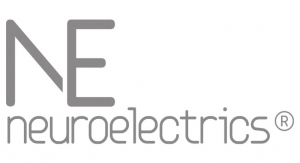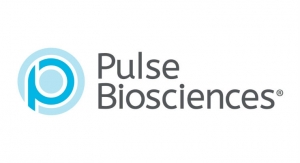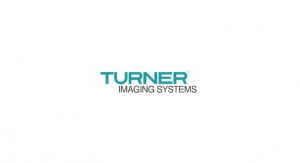Michael Barbella, Managing Editor11.09.20
Consider, for just one moment, the ability to monitor human brain activity at its source. Imagine the knowledge that could be gleaned by directly observing the non-stop electric symphony composed and conducted by a 120 billion-piece neuronal orchestra.
Fancy gaining a ringside seat to this cerebral concerto, without the need for big, bulky machines, strange-looking skull caps, or long, tangle-prone wires. A tiny, perhaps flexible, electrode would suffice as the entrance fee.
To truly witness the magical harmony of the brain’s electric oscillations, that electrode would have to be extremely small—conceivably, 100 nanometers or so (roughly 1,000 times thinner than a human hair).
Creating an electrode of that size certainly is technologically possible. Medical electronics have steadily been shrinking over the last two decades as digital health and minimally invasive surgical procedures spawned a worldwide thirst for smaller, more complex computerized devices that improve diagnoses and tracking. The scramble for diagnostic tests, personal protective equipment, ventilators, and other medical supplies associated with the planet’s battle against COVID-19 is expected to increase demand for medical electronics over the next seven years.
Medical Product Outsourcing’s September feature, “Mission Complete,” details the various trends and challenges currently shaping the custom medical electronics market. Matt Shinew, director of technology for twisthink, was among the experts interviewed for this story. His full input is provided in the following Q&A:
Michael Barbella:What factors must be taken into consideration when designing electronic components for medical devices?
Matt Shinew: Any time you’re designing something new there are going to be several factors to consider, as well as some that will emerge that were unanticipated. That said, key factors that remain top of mind as we design electronic components include:
Barbella: Please discuss some of the challenges in designing and manufacturing electronic components for medical devices. How has your company overcome these challenges?
Shinew: We have found that battery-powered devices are typically desired by the end user. But due to the autoclave requirement, batteries also need to be removed. This presents challenges with exposed contacts and latching/locking mechanism, as well as making it intuitive for the user to remove the battery and charge it. Through collaboration among user experience designers alongside electronics engineers and mechanical engineers, we are able to overcome these challenges and provide an intuitive user experience that doesn’t compromise the innovative design and function.
Barbella: What are customers demanding or expecting in their electronic components?
Shinew: Many of our client’s desire to launch multiple products that share many core features. That is creating a demand for reusable components. Designing electronics for each of these products is not cost effective and it slows down the time to market. Our approach is to design circuits to be as modular as possible to maximize efficiencies. No balance is ever perfect, but we strive to achieve the right tradeoffs between cost optimization, size, and modularity.
Barbella: How is IoT (Internet of Things) influencing electronic component development?
Shinew: Everyone wants their products to be connected. In some cases, the value of having the device connected is not yet understood, but we can help them see the business case for connectivity. As the costs for common wireless interfaces like Bluetooth and wifi continue to become more affordable, we are finding more clients wanting these included in their designs for future use.
Barbella: How is big data influencing electronic component development?
Shinew: Data can provide companies with valuable insights to improve operations, provide better customer service, and ultimately increase profitability. Medical products are a key component to bringing these values to medical providers. However, one of the big challenges with “big data” is capturing the right data—the right data increases value generation by providing new information that was previously unavailable. When new information is available, new insights and trends can be uncovered using data analytics.
The need to access new information is driving the inclusion of new sensors—sensors that provide insights into how the component is being used or insights into the environment where the component is being used. This in turn is driving innovation in sensing technology—things like miniaturization, low-power options, and conversion to digital sensing.
When developing an electronic component for the medical space, it is important to ask: “What data will provide new value for the end user and our business and how can I collect it?” It’s important to answer this question with information and trends uncovered with the right data and analytics.
Barbella: How is AI (artificial intelligence) influencing electronic component development?
Shinew: In the world of AI and embedded system development, there is a growing trend to push AI away from the cloud and to “the edge”—directly to the electronic components that function in the environment. In essence, this trend is decentralizing intelligence—putting intelligent functions where they bring the most value, enabling new user experiences through real-time decisions.
AI is influencing electronic component develop in three ways:
Barbella: How is the trend toward miniaturization of medical devices driving the design of electronic components? Please explain.
Shinew: The desire for smaller electronic components has always been at odds with cost, robustness, and performance. However, the consumer electronics industry is helping drive higher performance and higher density silicon packages down in cost. This is driving the design of electronics to make use of these more mainstream, high-volume silicon solutions. Another effect of miniaturization is to lean more heavily on determining what the true need is for the product. Many times it is assumed that a product needs to have certain features, then after interviewing end users, several features or requirements can be reduced to allow the electronics to become much smaller.
Barbella: In what ways is the changing regulatory environment impacting electronic component development?
Shinew: To date, our work hasn’t been significantly impacted by regulatory issues. However, it is something we’re monitoring closely and will be ready to pivot as the regulatory environment changes.
Barbella: The industry has grappled with a worldwide electronic components shortage in recent years. What solutions are available to tackle this problem?
Shinew: We’ve experienced this firsthand as well and need to be equipped with solutions and alternatives as demand continues to rise. Over the past few years we have designed in multiple sources for as many of the components as possible; purchased in bulk for unique components such as processors or specialty analog ICs, a bulk purchase is sometimes considered; and where the design can support it, provisioned for an alternate size. For example, if a shortage occurs around a specific size and component type, like -0402 ceramic capacitors, then alternating with a model like a -0603 or -0805, offers us an easy solution.
Barbella: Component obsolescence is a challenge in the medtech industry, where the product lifecycle is very long compared to many consumer devices. How can this challenge be overcome?
Shinew: Unfortunately, there isn’t a silver bullet here, but here are a few ways to deal with this reality:
Barbella: Please discuss any other trends you are noticing in electronic component development (medical devices).
Shinew: The adoption of open-source software continues to gain momentum. Software is a large part of the electronic device development effort. The increasing complexity of software driver and middleware layers is making open-source software more attractive while also addressing reuse and increased speed to market that is desired.
Fancy gaining a ringside seat to this cerebral concerto, without the need for big, bulky machines, strange-looking skull caps, or long, tangle-prone wires. A tiny, perhaps flexible, electrode would suffice as the entrance fee.
To truly witness the magical harmony of the brain’s electric oscillations, that electrode would have to be extremely small—conceivably, 100 nanometers or so (roughly 1,000 times thinner than a human hair).
Creating an electrode of that size certainly is technologically possible. Medical electronics have steadily been shrinking over the last two decades as digital health and minimally invasive surgical procedures spawned a worldwide thirst for smaller, more complex computerized devices that improve diagnoses and tracking. The scramble for diagnostic tests, personal protective equipment, ventilators, and other medical supplies associated with the planet’s battle against COVID-19 is expected to increase demand for medical electronics over the next seven years.
Medical Product Outsourcing’s September feature, “Mission Complete,” details the various trends and challenges currently shaping the custom medical electronics market. Matt Shinew, director of technology for twisthink, was among the experts interviewed for this story. His full input is provided in the following Q&A:
Michael Barbella:What factors must be taken into consideration when designing electronic components for medical devices?
Matt Shinew: Any time you’re designing something new there are going to be several factors to consider, as well as some that will emerge that were unanticipated. That said, key factors that remain top of mind as we design electronic components include:
- Reliability—We always want to enhance product reliability. Designing with margins of 50 percent for voltage and thermal ratings on every component helps us increase it.
- Thermal Management—Many medical devices need to be sealed for cleaning. This drives a more complex strategy for managing the dissipation of heat produced by the electronics.
- Sterilization/Autoclave—Electronic devices that go through an autoclave require every component to survive repeated exposure to high temperatures.
- Battery Management—Replacing, charging, and knowing the status of a battery-powered device is critical the user experience, but usually not the most desired feature. But making this experience as intuitive as possible cannot be overlooked or simply figured out at the end of the design.
- Usability—While all the above factors are important, usability is the most important. If a product isn’t highly usable and highly desirable by its users, then meeting all the other factors won’t matter.
Barbella: Please discuss some of the challenges in designing and manufacturing electronic components for medical devices. How has your company overcome these challenges?
Shinew: We have found that battery-powered devices are typically desired by the end user. But due to the autoclave requirement, batteries also need to be removed. This presents challenges with exposed contacts and latching/locking mechanism, as well as making it intuitive for the user to remove the battery and charge it. Through collaboration among user experience designers alongside electronics engineers and mechanical engineers, we are able to overcome these challenges and provide an intuitive user experience that doesn’t compromise the innovative design and function.
Barbella: What are customers demanding or expecting in their electronic components?
Shinew: Many of our client’s desire to launch multiple products that share many core features. That is creating a demand for reusable components. Designing electronics for each of these products is not cost effective and it slows down the time to market. Our approach is to design circuits to be as modular as possible to maximize efficiencies. No balance is ever perfect, but we strive to achieve the right tradeoffs between cost optimization, size, and modularity.
Barbella: How is IoT (Internet of Things) influencing electronic component development?
Shinew: Everyone wants their products to be connected. In some cases, the value of having the device connected is not yet understood, but we can help them see the business case for connectivity. As the costs for common wireless interfaces like Bluetooth and wifi continue to become more affordable, we are finding more clients wanting these included in their designs for future use.
Barbella: How is big data influencing electronic component development?
Shinew: Data can provide companies with valuable insights to improve operations, provide better customer service, and ultimately increase profitability. Medical products are a key component to bringing these values to medical providers. However, one of the big challenges with “big data” is capturing the right data—the right data increases value generation by providing new information that was previously unavailable. When new information is available, new insights and trends can be uncovered using data analytics.
The need to access new information is driving the inclusion of new sensors—sensors that provide insights into how the component is being used or insights into the environment where the component is being used. This in turn is driving innovation in sensing technology—things like miniaturization, low-power options, and conversion to digital sensing.
When developing an electronic component for the medical space, it is important to ask: “What data will provide new value for the end user and our business and how can I collect it?” It’s important to answer this question with information and trends uncovered with the right data and analytics.
Barbella: How is AI (artificial intelligence) influencing electronic component development?
Shinew: In the world of AI and embedded system development, there is a growing trend to push AI away from the cloud and to “the edge”—directly to the electronic components that function in the environment. In essence, this trend is decentralizing intelligence—putting intelligent functions where they bring the most value, enabling new user experiences through real-time decisions.
AI is influencing electronic component develop in three ways:
- AI algorithms are power hungry and require high levels of onboard processing capability. The design and development of electronic components will start to include specialized hardware accelerators to meet processing demands.
- AI thrives in data-rich environments. Moving AI to the edge will drive the inclusion of new sensors or sensors with increased capabilities.
- Developing AI algorithms requires a unique skill-set—machine learning engineers are well versed dealing with data, training pipelines, statistics, and higher-level coding languages. The inclusion of AI algorithms will require electronic component development teams to acquire new skills and partnerships with service firms that can provide AI expertise.
Barbella: How is the trend toward miniaturization of medical devices driving the design of electronic components? Please explain.
Shinew: The desire for smaller electronic components has always been at odds with cost, robustness, and performance. However, the consumer electronics industry is helping drive higher performance and higher density silicon packages down in cost. This is driving the design of electronics to make use of these more mainstream, high-volume silicon solutions. Another effect of miniaturization is to lean more heavily on determining what the true need is for the product. Many times it is assumed that a product needs to have certain features, then after interviewing end users, several features or requirements can be reduced to allow the electronics to become much smaller.
Barbella: In what ways is the changing regulatory environment impacting electronic component development?
Shinew: To date, our work hasn’t been significantly impacted by regulatory issues. However, it is something we’re monitoring closely and will be ready to pivot as the regulatory environment changes.
Barbella: The industry has grappled with a worldwide electronic components shortage in recent years. What solutions are available to tackle this problem?
Shinew: We’ve experienced this firsthand as well and need to be equipped with solutions and alternatives as demand continues to rise. Over the past few years we have designed in multiple sources for as many of the components as possible; purchased in bulk for unique components such as processors or specialty analog ICs, a bulk purchase is sometimes considered; and where the design can support it, provisioned for an alternate size. For example, if a shortage occurs around a specific size and component type, like -0402 ceramic capacitors, then alternating with a model like a -0603 or -0805, offers us an easy solution.
Barbella: Component obsolescence is a challenge in the medtech industry, where the product lifecycle is very long compared to many consumer devices. How can this challenge be overcome?
Shinew: Unfortunately, there isn’t a silver bullet here, but here are a few ways to deal with this reality:
- Choose to design in a newer, often more expensive, higher performance part assuming that its cost will reduce as it becomes more mainstream in the years to come and since it is new, it has the longest life ahead of it.
- Design an architecture for the electronics that is generic to the specific parts that are chosen, such as processors and analog ICs. While there may not be pin for pin compatible parts available as alternates, at least the function of the part is not so unique that the architecture of the electronics is built around it.
- Using a common part family from a larger supplier increases the likelihood that if or when a part does become obsolete, the supplier will have already released a newer component that is capable of replacing the obsoleted one and typically provides design guidelines on how to transition your design over to this new part.
Barbella: Please discuss any other trends you are noticing in electronic component development (medical devices).
Shinew: The adoption of open-source software continues to gain momentum. Software is a large part of the electronic device development effort. The increasing complexity of software driver and middleware layers is making open-source software more attractive while also addressing reuse and increased speed to market that is desired.























